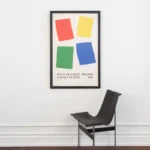William Golding’s Lord of the Flies is a gripping novel that explores the dark side of human nature through a group of boys stranded on a deserted island. The novel delves into themes of power, civilization, and the descent into savagery, offering a raw and thought-provoking commentary on society.
To truly understand the depth of this novel, it helps to employ vivid adjectives that capture the essence of its setting, characters, and atmosphere. In this article, we’ll explore 10 vivid adjectives to describe Lord of the Flies that bring the story to life and enhance its vivid imagery. Let’s dive in!
Why Adjectives Matter in Lord of the Flies
Before we explore the adjectives themselves, it’s important to understand why they are so crucial in describing Lord of the Flies. Golding’s narrative is not just about plot—it’s about the experience, the atmosphere, and the emotional impact of the events. The novel is teeming with tension, fear, and chaos. Using vivid adjectives helps readers grasp the profound impact of these elements. These words not only describe the physical environment but also reflect the psychological states of the characters, creating an immersive experience.
10 Vivid Adjectives to Describe Lord of the Flies
1. Savage
One of the most defining aspects of Lord of the Flies is the boys’ descent into savagery. The island, which starts as a pristine paradise, transforms into a place where violence and brutality reign. The adjective “savage” perfectly encapsulates the primal instincts that the boys embrace as they move further away from the civilized world. It’s a raw word that evokes the collapse of order and the rise of chaos.
Example: “The savage cries echoed through the jungle, as the boys gave in to their darkest impulses.”
2. Dark
“Dark” is an adjective that serves many purposes in Lord of the Flies. It refers not only to the literal absence of light on the island, particularly during the night when terror sets in, but also to the metaphorical darkness of the human soul. It hints at the evil that emerges as the boys forsake their civility. The dark is both an external and internal force, symbolizing the evil that takes hold.
Example: “As the sun dipped below the horizon, the dark shadow of violence began to loom over them.”
3. Chaotic
The island is not a place of order or peace. From the moment the boys begin to establish their own society, chaos reigns. The group’s attempts at creating rules and maintaining order quickly deteriorate, and the adjective “chaotic” aptly describes the rapid unraveling of their fragile social structure. It’s a word that conveys confusion, disarray, and a lack of control.
Example: “The chaotic scene unfolded as the boys fought for power, their once-innocent games turning deadly.”
4. Mysterious
The island itself is a mysterious entity in Lord of the Flies. From the dense jungle to the remote location, there is a sense of the unknown throughout the novel. The boys never fully understand the island, and it seems to hide secrets that contribute to their eventual unraveling. The adjective “mysterious” evokes the sense of an enigma that they are trapped within, with the island acting as both a physical and psychological puzzle.
Example: “The mysterious noises in the night made the boys uneasy, as if the island itself was watching them.”
5. Violent
The transformation of the boys from innocent children to brutal savages is marked by violence. The “violent” nature of the boys’ interactions with each other and the world around them underscores the breakdown of society and the rise of animalistic behavior. This word conveys the aggression and cruelty that replaces compassion and reason.
Example: “The violent clash between Ralph and Jack was inevitable, as their opposing beliefs sparked an uncontrollable fury.”
6. Frenzied
As tensions rise on the island, the boys’ behavior becomes increasingly frenzied. Their actions are marked by a sense of urgency and irrationality, whether it’s the madness of the hunt or the frantic assembly of a leadership group. “Frenzied” captures the disordered, almost manic nature of their descent into savagery, with no rational thought to guide them.
Example: “In a frenzied attempt to gain control, Jack’s followers rushed forward, ignoring the consequences of their actions.”
7. Tragic
At the heart of Lord of the Flies is a tragic story about the loss of innocence and the collapse of civilization. The boys start with the potential for a well-functioning society but descend into brutality and despair. “Tragic” is an adjective that reflects the devastating consequences of their actions and the inevitable breakdown of their society.
Example: “The tragic death of Simon marked the point of no return, where hope for order was finally lost.”
8. Primitive
The word “primitive” is central to understanding the regression of the boys into their most basic and animalistic instincts. As they abandon the structures of society, they become more primitive in their behaviors—resorting to violence, hunting, and ritualistic acts. It’s a stark contrast to the structured world they once knew.
Example: “The boys’ primitive rituals around the fire showcased their descent into barbarism, far from the innocence they once held.”
9. Tense
From the first moments on the island, there is an undercurrent of tension that grows throughout the novel. The boys’ struggles for power, control, and survival create an atmosphere thick with unease. The word “tense” perfectly encapsulates the constant threat of violence and the breakdown of relationships between the boys.
Example: “The tense standoff between Ralph and Jack revealed the fragile nature of their alliance, which was doomed to collapse.”
10. Foreboding
Lord of the Flies is filled with a sense of impending doom. Whether it’s the darkening skies, the boys’ growing fear, or the ominous figure of the “beast,” there is always a sense that something terrible is on the horizon. “Foreboding” is the perfect adjective to describe the feeling that dominates much of the novel, as the boys feel the weight of the world closing in on them.
Example: “A foreboding sense of danger hung in the air, as the boys could sense that something worse was coming.”

The Importance of Vivid Adjectives in Lord of the Flies
Using vivid adjectives like those listed above helps bring the world of Lord of the Flies to life. These words are not just descriptive—they’re integral to understanding the novel’s themes and the emotional states of the characters. The boys’ journey is one of gradual decline, and these adjectives mirror that transformation, making the novel’s events feel immediate and visceral. By selecting the right adjectives, readers can better appreciate the complexities of the story and the environment in which it unfolds.
In literature, the choice of adjectives helps shape the atmosphere. Lord of the Flies is not a light-hearted adventure story; it’s a dark, intense exploration of human nature. Adjectives like “savage,” “chaotic,” and “violent” not only convey the events but also encapsulate the emotional journey the characters go through as they shed their innocence and succumb to their baser instincts.

Conclusion
The 10 vivid adjectives to describe Lord of the Flies are more than just descriptive tools—they are essential to understanding the novel’s core themes. Each adjective offers a window into the psychological and emotional turmoil that the boys experience, reflecting their descent into chaos and savagery. These words are the key to unlocking the full impact of Golding’s powerful narrative.
As you reflect on the vivid imagery in Lord of the Flies, you might wonder: how would the story change if these adjectives were different?





